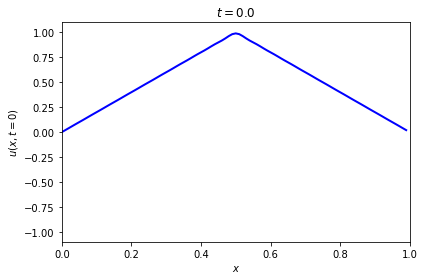Taylor Problem 16.14 version A
Taylor Problem 16.14 version A#
We’ll plot at various times a wave \(u(x,t)\) that is defined by its initial shape at \(t=0\) from \(x=0\) to \(x=L\), using a Fourier sine series to write the result at a general time t:
\(\begin{align} u(x,t) = \sum_{n=1}^{\infty} B_n \sin(k_n x)\cos(\omega_n t) \;, \end{align}\)
with \(k_n = n\pi/L\) and \(\omega_n = k_n c\), where \(c\) is the wave speed. Here the coefficients are given by
\(\begin{align} B_n = \frac{2}{L}\int_0^L u(x,0) \sin\frac{n\pi x}{L} \, dx \;. \end{align}\)
Created 28-Mar-2019. Last revised 30-Mar-2019 by Dick Furnstahl (furnstahl.1@osu.edu).
This version sums only over odd n, which are called \(m = 2n + 1\).
%matplotlib inline
import numpy as np
import matplotlib.pyplot as plt
from matplotlib import animation, rc
from IPython.display import HTML
First define functions for the \(t=0\) wave function form (here a triangle) and for the subsequent shape at any time \(t\) based on the wave speed c_wave.
def B_coeff(m):
"""Fourier coefficient for the n = 2*m + 1 term in the expansion.
"""
temp = 2.*m + 1
return (-1)**m * 8. / (temp * np.pi)**2
def k(m, L):
"""Wave number for n = 2*m + 1.
"""
return (2.*m + 1.) * np.pi / L
def u_triangular(x_pts, t, m_max=20, c_wave=1., L=1.):
"""Returns the wave from the sum of Fourier components.
"""
y_pts = np.zeros(len(x_pts)) # define y_pts as the same size as x_pts
for m in np.arange(m_max):
y_pts += B_coeff(m) * np.sin(k(m, L) * x_pts) \
* np.cos(k(m, L) * c_wave * t)
return y_pts
First look at the initial (\(t=0\)) wave form.
L = 1.
m_max = 20
c_wave = 1
omega_1 = np.pi * c_wave / L
tau = 2.*np.pi / omega_1
# Set up the array of x points (whatever looks good)
x_min = 0.
x_max = L
delta_x = 0.01
x_pts = np.arange(x_min, x_max, delta_x)
# Make a figure showing the initial wave.
t_now = 0.
fig = plt.figure(figsize=(6,4), num='Standing wave')
ax = fig.add_subplot(1,1,1)
ax.set_xlim(x_min, x_max)
gap = 0.1
ax.set_ylim(-1. - gap, 1. + gap)
ax.set_xlabel(r'$x$')
ax.set_ylabel(r'$u(x, t=0)$')
ax.set_title(rf'$t = {t_now:.1f}$')
line, = ax.plot(x_pts,
u_triangular(x_pts, t_now, m_max, c_wave, L),
color='blue', lw=2)
fig.tight_layout()

Next make some plots at an array of time points.
t_array = tau * np.arange(0., 1.125, .125)
fig_array = plt.figure(figsize=(12,12), num='Standing wave')
for i, t_now in enumerate(t_array):
ax_array = fig_array.add_subplot(3, 3, i+1)
ax_array.set_xlim(x_min, x_max)
gap = 0.1
ax_array.set_ylim(-1. - gap, 1. + gap)
ax_array.set_xlabel(r'$x$')
ax_array.set_ylabel(r'$u(x, t)$')
ax_array.set_title(rf'$t = {t_now/tau:.3f}\tau$')
ax_array.plot(x_pts,
u_triangular(x_pts, t_now, m_max, c_wave, L),
color='blue', lw=2)
fig_array.tight_layout()
fig_array.savefig('Taylor_Problem_16p14.png',
bbox_inches='tight')

Now it is time to animate!
# Set up the t mesh for the animation. The maximum value of t shown in
# the movie will be t_min + delta_t * frame_number
t_min = 0. # You can make this negative to see what happens before t=0!
t_max = 2.*tau
delta_t = t_max / 100.
t_pts = np.arange(t_min, t_max + delta_t, delta_t)
We use the cell “magic” %%capture to keep the figure from being shown here. If we didn’t the animated version below would be blank.
%%capture
fig_anim = plt.figure(figsize=(6,3), num='Triangular wave')
ax_anim = fig_anim.add_subplot(1,1,1)
ax_anim.set_xlim(x_min, x_max)
gap = 0.1
ax_anim.set_ylim(-1. - gap, 1. + gap)
# By assigning the first return from plot to line_anim, we can later change
# the values in the line.
line_anim, = ax_anim.plot(x_pts,
u_triangular(x_pts, t_min, m_max, c_wave, L),
color='blue', lw=2)
fig_anim.tight_layout()
def animate_wave(i):
"""This is the function called by FuncAnimation to create each frame,
numbered by i. So each i corresponds to a point in the t_pts
array, with index i.
"""
t = t_pts[i]
y_pts = u_triangular(x_pts, t, m_max, c_wave, L)
line_anim.set_data(x_pts, y_pts) # overwrite line_anim with new points
return (line_anim,) # this is needed for blit=True to work
frame_interval = 80. # time between frames
frame_number = 101 # number of frames to include (index of t_pts)
anim = animation.FuncAnimation(fig_anim,
animate_wave,
init_func=None,
frames=frame_number,
interval=frame_interval,
blit=True,
repeat=False)
HTML(anim.to_jshtml()) # animate using javascript
